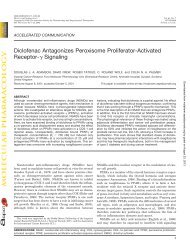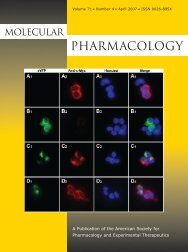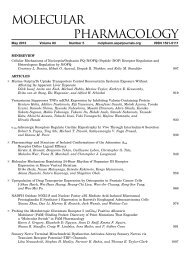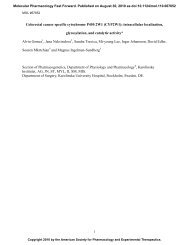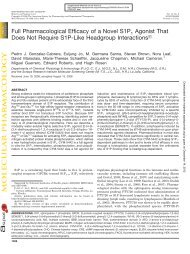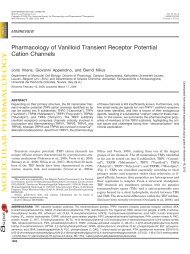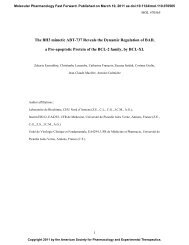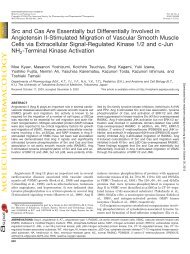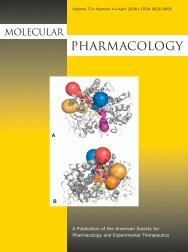car and pxr increase insig-1 expression - Molecular Pharmacology
car and pxr increase insig-1 expression - Molecular Pharmacology
car and pxr increase insig-1 expression - Molecular Pharmacology
Create successful ePaper yourself
Turn your PDF publications into a flip-book with our unique Google optimized e-Paper software.
<strong>Molecular</strong> <strong>Pharmacology</strong> Fast Forward. Published on February 21, 2008 as doi:10.1124/mol.107.041012<br />
MOL Manuscript #41012<br />
REGULATORY CROSSTALK BETWEEN DRUG<br />
METABOLISM AND LIPID HOMEOSTASIS: CAR AND PXR<br />
INCREASE INSIG-1 EXPRESSION<br />
Adrian Roth, Renate Looser, Michel Kaufmann, Sharon Blaettler, Franck Rencurel, Wendong<br />
Huang, David D. Moore<br />
<strong>and</strong> Urs A. Meyer<br />
Division of <strong>Pharmacology</strong>/Neurobiology, Biozentrum of the University of Basel, Klingelbergstrasse<br />
50-70, CH-4056 Basel, Switzerl<strong>and</strong> (AR, RL, MK, SB, FR, UAM); Department of Gene Regulation<br />
& Drug Discovery, Beckman Research Institute, City of Hope National Medical Center, 1500 East<br />
Duarte Road, Duarte, CA 91010, USA (WH); Department of <strong>Molecular</strong> <strong>and</strong> Cellular Biology, Baylor<br />
College of Medicine, One Baylor Plaza, Houston, TX 77030, USA (DDM)<br />
Copyright 2008 by the American Society for <strong>Pharmacology</strong> <strong>and</strong> Experimental Therapeutics.<br />
1
MOL Manuscript #41012<br />
Running Title: CAR <strong>and</strong> PXR induce Insig-1<br />
Corresponding Author: Urs A. Meyer<br />
Number of Text Pages : 25<br />
Number of Tables : 1<br />
Number of Figures : 6<br />
Number of References : 31<br />
Division of <strong>Pharmacology</strong>/Neurobiology<br />
Biozentrum of the University of Basel<br />
Klingelbergstrasse 50-70<br />
CH-4056 Basel<br />
Switzerl<strong>and</strong><br />
Phone +41 61 267 22 20<br />
Fax +41 61 267 22 08<br />
Number of words in the Abstract: 247<br />
Number of words in the Introduction: 437<br />
Number of words in the Discussion: 974<br />
Email Urs-A.Meyer@unibas.ch<br />
Nonst<strong>and</strong>ard abbreviations used : CAR, constitutive <strong>and</strong>rostane receptor; CYP, cytochromes P450;<br />
ER, endoplasmatic reticulum, HA, hemagglutinin; PB, Phenobarbital;<br />
PCN, pregnenolone-16α-<strong>car</strong>bonitrile; PXR, pregnane x receptor;<br />
TCPOBOP, 1,4-Bis[2-(3,5-dichloropyridyloxy)]benzene; AICAR, 5-<br />
aminoimidazole-4-<strong>car</strong>boxamide riboside<br />
2
ABSTRACT<br />
MOL Manuscript #41012<br />
Activation of PXR (pregnane x receptor) <strong>and</strong> CAR (constitutive <strong>and</strong>rostane receptor) by xenobiotic<br />
inducers of cytochromes P450 is part of a pleiotropic response that includes liver hypertrophy, tumor<br />
promotion, effects on lipid homeostasis <strong>and</strong> energy metabolism. Here we describe an acute response<br />
to CAR <strong>and</strong> PXR activators that is associated with induction of Insig-1, a protein with antilipogenic<br />
properties. We first observed that activation of CAR <strong>and</strong> PXR in mouse liver results in activation of<br />
Insig-1 along with reduced protein levels of the active form of sterol regulatory element binding<br />
protein 1 (Srebp-1). Studies in mice deficient in CAR <strong>and</strong> PXR revealed that the effect on<br />
triglycerides involves these two nuclear receptors. Finally, we identified a functional binding site for<br />
CAR <strong>and</strong> PXR in the Insig-1 gene by in vivo, in vitro <strong>and</strong> in silico genomic analysis. Our experiments<br />
suggest that activation of Insig-1 by drugs leads to reduced levels of active Srebp-1 <strong>and</strong> consequently<br />
to reduced target gene <strong>expression</strong> including the genes responsible for triglyceride synthesis. The<br />
reduction in nuclear Srebp-1 by drugs is not observed when Insig-1 <strong>expression</strong> is repressed by siRNA.<br />
In addition, we observed that Insig-1 is also a target of AMP-activated kinase (AMPK), the hepatic<br />
activity of which is <strong>increase</strong>d by activators of CAR <strong>and</strong> PXR, <strong>and</strong> which is known to cause a<br />
reduction of triglycerides. The fact that drugs which serve as CAR or PXR lig<strong>and</strong>s induce Insig-1<br />
might have clinical consequences <strong>and</strong> explains alterations in lipid levels after drug therapy.<br />
3
MOL Manuscript #41012<br />
Induction of cytochromes P450 (CYPs), other drug-metabolizing enzymes <strong>and</strong> drug transporters by<br />
their own substrates <strong>and</strong> other chemicals is an adaptive response of the liver to prevent accumulation<br />
of toxic xenobiotics <strong>and</strong> endobiotics. Xenosensors that mediate this response are the nuclear receptors<br />
pregnane X receptor (PXR) <strong>and</strong> constitutive active/<strong>and</strong>rostane receptor (CAR; for a review see<br />
(H<strong>and</strong>schin <strong>and</strong> Meyer, 2003)). PXR <strong>and</strong> CAR form heterodimers with the retinoid X receptor (RXR)<br />
<strong>and</strong> bind to specific DNA sequences in the regulatory region of target genes. PXR <strong>and</strong> CAR induce an<br />
overlapping set of genes involved in metabolism <strong>and</strong> transport of drugs (Maglich et al., 2002) but also<br />
genes involved in the regulation of steroids, bile acids, eicosanoids <strong>and</strong> genes involved in cholesterol<br />
<strong>and</strong> bile acid homeostasis (Huang et al., 2003; Staudinger et al., 2001) .<br />
Insig-1 <strong>and</strong> Insig-2 are proteins of endoplasmatic reticulum (ER) membrane <strong>and</strong> play an important<br />
role in the control of triglyceride <strong>and</strong> cholesterol biosynthesis (Yabe et al., 2002; Yang et al., 2002).<br />
The two isoforms bind in a sterol-dependent fashion to another ER membrane protein, sterol<br />
regulatory element binding protein (Srebp) cleavage-activating protein, or Scap, a transport protein<br />
needed for escort <strong>and</strong> subsequent activation of Srebp transcription factors (Hua et al., 1996). When<br />
Insig proteins are activated by sterols, insulin or other stimuli, they retain the Scap-Srebp complex in<br />
the ER membrane thereby preventing Srebp-dependent target gene <strong>expression</strong>. Srebp’s are a group of<br />
basic helix loop helix transcription factors, which activate an array of genes involved in the synthesis<br />
of cholesterol <strong>and</strong> triglycerides. While Srebp-2 is mainly involved in cholesterol biosynthesis, Srebp-<br />
1a <strong>and</strong> Srebp1c mainly activate genes involved in fatty acid <strong>and</strong> triglyceride synthesis (Shimano,<br />
2001).<br />
A decrease in hepatic <strong>and</strong>/or serum lipids, in particular triglycerides, has been observed in rodents<br />
after treatment with inducers of xenobiotic metabolism many years ago (Bjondahl, 1978; Hall et al.,<br />
1990; Venkatesan et al., 1994). More recently, known inducers of human drug metabolism such as the<br />
commonly used anti-retroviral drug efavirenz or the barbiturate phenobarbital (PB) also have been<br />
shown to inhibit lipogenesis (Hadri et al., 2004; Kiyosawa et al., 2004). The molecular mechanism of<br />
the effect of inducers on triglycerides has not been explained.<br />
4
MOL Manuscript #41012<br />
In the present study we show that nuclear receptors CAR <strong>and</strong> PXR transcriptionally activate Insig-1<br />
by binding to an enhancer sequence of the Insig-1 gene. Our results explain the negative effect of<br />
drugs <strong>and</strong> xenobiotics on hepatic lipids in vivo <strong>and</strong> show that CAR <strong>and</strong> PXR not only play a role in<br />
the catabolism of various endogenous <strong>and</strong> exogenous compounds but also directly affect lipogenic<br />
pathways by activating Insig-1. Moreover, as Insig-1 has recently been found to be a possible drug<br />
target for the treatment of diabetes (Nakagawa et al., 2006), this study contributes to the<br />
underst<strong>and</strong>ing of the regulation of this gene <strong>and</strong> possibly to the development of new therapies against<br />
dislipidemia.<br />
5
MATERIALS & METHODS<br />
Animals<br />
MOL Manuscript #41012<br />
C57BL/6 mice were maintained in a 12-hour light/12-hour dark cycle <strong>and</strong> had free access to food <strong>and</strong><br />
drinking water. 9-11 week old male animals received an i.p. injection of either 100 mg/Kg<br />
phenobarbital (PB, Sigma, Buchs, Switzerl<strong>and</strong>), 10 mg/Kg 1,4-Bis[2-(3,5-<br />
dichloropyridyloxy)]benzene (TCPOBOP; Bayer, Leverkusen, FRG) or 40 mg/Kg pregnenolone-16α-<br />
<strong>car</strong>bonitrile (PCN; Sigma, Buchs, Switzerl<strong>and</strong>) in a 5% DMSO-corn oil solution i.p. or with vehicle<br />
10h before dissection. Animals were sacrificed by exposure to CO2, blood was collected by heart<br />
puncture, livers excised <strong>and</strong> snap-frozen in liquid nitrogen <strong>and</strong> stored at -80°C until use.<br />
Analysis of Triglycerides <strong>and</strong> Cholesterol<br />
50-100 mg of liver was used for each preparation. After weight determination, liver samples were put<br />
in an ethanol: ether (3:1, v/v) mixture in Fastprep tubes (Lysing matrix D, Qbiogene, Basel,<br />
Switzerl<strong>and</strong>). Livers were homogenized on the Fastprep instrument for 40s at position 6,5 <strong>and</strong><br />
evaporated to complete dryness on a Speed-vac evaporator. Samples were redissolved in 1ml<br />
isopropanol <strong>and</strong> tissue remnants spun down for 5 minutes at 14000 xg. 600 µl of the supernatant was<br />
mixed with 400 µl of water <strong>and</strong> lipids were determined using the esterase/oxidase kit for cholesterol<br />
determination <strong>and</strong> the L-α-glycerol phosphate oxidase kit for the determination of triglycerides<br />
(Roche Diagnostics, Rotkreuz, Switzerl<strong>and</strong>).<br />
RT PCR Analysis<br />
RNA from cells <strong>and</strong> tissues was isolated using Tri-Reagent (Sigma, Buchs, Switzerl<strong>and</strong>). One<br />
microgram total RNA was reverse-transcribed with MMLV reverse transcriptase (Roche <strong>Molecular</strong><br />
Biochemicals, Rotkreuz, Switzerl<strong>and</strong>). PCR was performed using the TaqMan PCR Core Reagent Kit<br />
(PE Applied Biosystems, Rotkreuz, Switzerl<strong>and</strong>) <strong>and</strong> the transcript level quantitated with an ABI<br />
6
MOL Manuscript #41012<br />
PRISM 7700 Sequence Detection System (PE Applied Biosystems, Rotkreuz, Switzerl<strong>and</strong>) according<br />
to the manufacturer’s protocol. Briefly, relative transcript levels were determined using the relative<br />
quantitation method by measuring the ∆Ct between the gene of interest <strong>and</strong> the internal control<br />
GAPDH. Primers <strong>and</strong> fluorescent probes used in these PCRs are listed in Table 1.<br />
Reporter Gene Assays<br />
Culture <strong>and</strong> transfection of CV-1 cells with Lipofectamine Transfection Reagent (Invitrogen,<br />
Carlsbad, USA) was performed as previously published (H<strong>and</strong>schin et al., 2000). Expression vectors<br />
encoding mouse PXR <strong>and</strong> mouse CAR as well as the beta-galactosidase vector used for signal<br />
normalization have been described (H<strong>and</strong>schin et al., 2002). For construction of hemaglutinin-tagged<br />
vp16 fusion proteins nuclear receptor sequences were amplified from <strong>expression</strong> plasmids <strong>and</strong><br />
subcloned into pcDNA3/vp16-HA (a kind gift from Dr. Dieter Kressler, Biozentrum, University of<br />
Basel, Switzerl<strong>and</strong>). Reporter vectors were based on PGL3-LUC (Promega, Wallisellen, Switzerl<strong>and</strong>).<br />
Genomic DNA from the murine Insig1 enhancer region was amplified using PCR primers <strong>car</strong>rying<br />
restriction sites suitable for direct subcloning into the reporter vector.<br />
Preparation of Primary Hepatocytes<br />
For the preparation of mouse hepatocytes animals were anaesthetized with Ketamine/Xylazine (Sigma,<br />
Buchs, Switzerl<strong>and</strong>). The portal vein was canulated <strong>and</strong> perfused with HEPES-EGTA (pH 7.4) for 5<br />
minutes <strong>and</strong> then with collagenase (type 2, Worthington, Lakewood NJ, USA) for 6 minutes. The<br />
livers were excised, cells were filtered through a nylon mesh <strong>and</strong> centrifuged at 50 xg at 4°C for 5<br />
minutes three times. After determination of viability, cells were plated at a density of 400’000<br />
cells/well (12 well plate) <strong>and</strong> were allowed to attach for 2 hours in William’s E medium without<br />
phenol red (Invitrogen, Basel, Switzerl<strong>and</strong>), 10 % FCS, 4µg/ml insulin, 200µM glutamine <strong>and</strong> 1%<br />
penicillin/streptomycin (50 IU/ml) on collagen-coated dishes. Induction experiments were performed<br />
7
MOL Manuscript #41012<br />
in the same medium without FCS <strong>and</strong> with reduced insulin (2 µg/ml) but with the addition of 1 µM<br />
hydrocortisone.<br />
Primary human hepatocytes in suspension were allowed to attach on collagen-coated plates in DMEM<br />
supplemented with 10% FBS, 1% penicillin/streptomycin (50 IU/ml) <strong>and</strong> 1 µM dexamethasone<br />
overnight before start of the experiments. For induction cells were cultured in DMEM without serum<br />
but supplemented with insulin-transferrine-selenium mixture (Sigma, Buchs, Switzerl<strong>and</strong>) <strong>and</strong> 1µM<br />
hydrocortisone<br />
Production of recombinant adenovirus particles<br />
Expression cassettes of interest were PCR-amplified using vector-specific primers with attB1/attB2-<br />
Gateway extensions for subsequent cloning into pDONR221 (Invitrogen, Carlsbad, CA, USA). For<br />
pcDNA3 constructs (Vp16-PXR, Vp16-CAR) the following primers were used:<br />
TTAGGGTTAGGCGTTTTGCGC (Fwd), TCAGAAGCCATAGAGCCCAC (Rev). Entry clones<br />
<strong>car</strong>rying the PCR products were used for cloning into pAd-DEST (Invitrogen, Carlsbad, CA, USA).<br />
PacI-digested plasmids were transfected into HEK293A cells <strong>and</strong> adenovirus particles produced <strong>and</strong><br />
processed according to the manufacturer’s recommendations (Invitrogen, Carlsbad, CA, USA).<br />
Functionality of PXR- <strong>and</strong> CAR-expressing adenoviruses was assessed in reporter gene assays in CV-<br />
1 cells using PXR- <strong>and</strong> CAR-responsive reporter vectors. We also tested the recombinant proteins in<br />
mouse hepatocytes by measuring mRNA <strong>expression</strong> of the target genes Cyp3a11 <strong>and</strong> Cyp2b10,<br />
respectively (data not shown).The adenovirus particles encoding recombinant forms of AMPK have<br />
been described (20)<br />
Immunoblotting, Gel-Mobility-Shift Assay & Chromatin Immunoprecipitation<br />
For Western blot analysis of SREBP1, liver proteins were extracted from 100-200 mg of frozen tissue<br />
in 1 ml ice-cold buffer (50 mM Tris-HCl pH 7.4, 100mM KCl, 1mM EDTA pH 8.0, 10mM beta-<br />
Mercaptoethanol, 5mM DTT, 0.1% (v/v) Triton X-100, 0.1% (v/v) NP 40, 1 tablet/50ml buffer<br />
8
MOL Manuscript #41012<br />
Protease Inhibitor Cocktail (Roche Diagnostics, Rotkreuz, Switzerl<strong>and</strong>)) in a 5 ml polystyrene tube<br />
using a Polytron Rotor-Stator Homogenizer. The homogenate was centrifuged for 30 min at 10000<br />
rpm at 4°C <strong>and</strong> 50 µg of protein was loaded on a 10% SDS-gel. SREBP1 isoforms were detected<br />
using mouse anti-SREBP1 monoclonal antibody (Anti-SREBP1 monoclonal #557036, Clone IgG-<br />
2A4BD, Pharmingen, Allschwil, Switzerl<strong>and</strong>).<br />
Transcription factors were synthesized in vitro by using the TNT T7 Quick Coupled<br />
Transcription/Translation System (Promega, Wallisellen, Switzerl<strong>and</strong>) according to the<br />
manufacturer's instructions. Probes were labeled with the Klenow fragment of DNA polymerase in the<br />
presence of radiolabeled [ -32P]ATP, <strong>and</strong> the probe was purified over a Biospin 6 chromatography<br />
column. A volume of labelled oligonucleotide corresponding to 100,000 cpm was used for each<br />
reaction in 10 mM Tris HCl, pH 8.0/40 mM KCl/0.05% Nonidet P-40/6% (vol/vol) glycerol/1 mM<br />
DTT containing 0.2 µg of poly(dI-dC) poly(dI-dC) <strong>and</strong> 2.5 µl of the in vitro synthesized proteins as<br />
described previously (H<strong>and</strong>schin et al.). The mix was incubated for 20 min at room temperature <strong>and</strong><br />
subsequently electrophoresed on a 6% polyacrylamide gel in 0.5× Tris/borate/EDTA buffer (1x TBE<br />
buffer is composed of 0.9 M Tris-Borate, 0.002 M EDTA, pH 8.3) followed by autoradiography at<br />
70°C. Oligos used for EMSAs were obtained as follows: For the mouse Insig-1 DR4 the following<br />
oligonucleotide were annealed <strong>and</strong> labelled using polynucleotide kinase:<br />
CCTGAGGGTCAACAGAGGACACCTAG (Fwd) <strong>and</strong> CTAGGTGTCCTCTGTTGACCCTCAGG<br />
(Rev).<br />
Chromatin Immunoprecipitation was performed using the EZ-Chip kit from Upstate<br />
(Charlottesville, USA). Primary mouse hepatocytes were infected with adenoviral particles encoding<br />
HA-tagged vp16-mouse CAR or mouse PXR, respectively. After 24 hours cells were harvested <strong>and</strong><br />
samples processed according to the manufacturers recommendations. For immunoprecipitation<br />
hemagglutinin (HA) antibody (monoclonal HA.11 clone 16B12 mouse IgG1 MMS-101P) from<br />
Covance (Princeton, USA)was used.<br />
9
MOL Manuscript #41012<br />
Targeting of Insig-1 in primary mouse hepatocytes by siRNA<br />
For the transfection of primary mouse hepatocytes, Dharmafect1 transfection reagent (#T2001-01,<br />
Dharmacon, Chicago, USA) was used. 100nM siRNAs (siGenome SmartPool mINSIG1 #M-060068-<br />
00; siControl Nontargeting siRNAPool#2 #D-001206-14-05; Dharmacon, Chicago, USA) <strong>and</strong> 14µl<br />
Dharmafect were used according to the manufacturer’s instructions. 6h after transfection medium was<br />
removed <strong>and</strong> replaced with fresh medium without serum. 24h later, medium was replace by medium<br />
containing 500µM phenobarbital <strong>and</strong> mRNAs <strong>and</strong> Srebp-1 protein analyzed after 24h as described.<br />
10
RESULTS<br />
MOL Manuscript #41012<br />
Mice were injected with drugs known to activate nuclear receptors PXR <strong>and</strong> CAR, namely<br />
phenobarbital (PB, activator of both PXR <strong>and</strong> CAR), pregnenolone-16α-<strong>car</strong>bonitrile (PCN, activator<br />
of PXR) <strong>and</strong> 1,4-Bis[2-(3,5-dichloropyridyloxy)]benzene (TCPOBOP, activator of CAR; Fig. 1).<br />
After 10 hours of exposure, liver samples were analyzed for hepatic triglycerides <strong>and</strong> cholesterol (Fig.<br />
1, top panel). All three drugs caused a substantial drop in triglycerides, whereas cholesterol levels<br />
were less affected. PB <strong>and</strong> TCPOBOP at the doses applied resulted in a 49% or 67% decrease in<br />
triglycerides, respectively, <strong>and</strong> a 28% or 33% decrease in cholesterol. Serum analysis of PB-treated<br />
animals revealed no significant change in triglycerides or cholesterol at 10 hours (Fig. 1, top panel,<br />
right). RT-PCR analysis of these livers showed marked induction of Insig-1 mRNA (Fig. 1, middle<br />
panel). The mRNA levels of Insig-2 were not significantly induced by drug treatment (data not<br />
shown) <strong>and</strong> mRNA levels of Srebp genes remained unaffected by drug treatment as well. Accordingly,<br />
Hmg-CoA reductase (Hmgcr), a target gene of Srebp-2 (Horton et al., 1998) was unchanged while<br />
Stearoyl-CoA desaturase 1 (Scd-1), which is a target gene of Srebp-1 (Shimano et al., 1999), was<br />
reduced after drug treatment. Again, TCPOBOP showed strongest effects (Fig. 1, middle panel).<br />
Whether the reduction in hepatic triglycerides was due to reduced nuclear <strong>expression</strong> of Srebp-1 was<br />
tested by immunoblotting of liver protein extracts from drug-treated animals using an antibody which<br />
can discriminate between the inactive precursor form of Srebp1 <strong>and</strong> the activated nuclear (mature)<br />
form of Srebp-1 (Fig. 2A). The graph shows a reduction in nuclear content of Srebp-1 in drug-treated<br />
mice with strongest effects by PB <strong>and</strong> TCPOBOP. A time course experiment in primary mouse<br />
hepatocytes revealed that the time-dependent induction profile of Insig-1 mRNA paralleled the one of<br />
the classic CAR- <strong>and</strong> PXR-inducible gene Cyp2b10 (Fig. 2B).<br />
To define the role for PXR <strong>and</strong> CAR in the activation of Insig1 <strong>and</strong> the subsequent drop in hepatic<br />
triglycerides we applied PB to mice deficient in these two receptors (Zhang et al., 2004), Fig. 3). Fig.<br />
3 shows that two typical target genes of PXR <strong>and</strong> CAR, Cyp2b10 <strong>and</strong> Cyp3a11, expectedly were not<br />
11
MOL Manuscript #41012<br />
inducible by PB in PXR/CAR null mice. Blunted induction of Insig-1 mRNA in these animals after<br />
PB treatment as well as an unchanged triglyceride profile compared to wild type animals was<br />
observed (Fig. 3, lower panels). These data support a PXR/CAR-dependent mechanism for the<br />
triglyceride-lowering effect of inducer compounds.<br />
We therefore designed experiments to identify functional binding sites for the PXR <strong>and</strong> CAR in the<br />
regulatory region of Insig-1. Two 3kb fragments of genomic DNA from the 5’-flanking region of the<br />
Insig1 gene were cloned into a luciferase reporter vector <strong>and</strong> activity was assessed in transactivation<br />
assays in CV-1 cells (Fig. 4A). The first DNA element spanned the transcriptional start site including<br />
the proximal promoter of Insig1 to -3044 bp <strong>and</strong> showed no activation after drug treatment. The<br />
second large DNA stretch was overlapping with the first one <strong>and</strong> ended at –6252bp. There was slight<br />
(as compared to empty control luciferase vector) activation of reporter gene transcription after drug<br />
treatment. This DNA element was cut into smaller pieces <strong>and</strong> activity assessed until a 760 bp<br />
fragment revealed a robust response to PXR <strong>and</strong> CAR. Within this fragment a DR-4 type drug<br />
response element was identified using the Nubiscan algorithm (Podvinec et al., 2002). This element<br />
responded well to PXR <strong>and</strong> CAR <strong>and</strong> specificity was assessed using a mutated version of the DR-4<br />
element, which resulted in a decreased response to drugs (Fig. 4A). The same DR-4 element was used<br />
in electromobility shift assays together with in vitro translated PXR, CAR <strong>and</strong> their heterodimeric<br />
partner, RXR (Fig. 4B). A strong b<strong>and</strong> was observed when CAR <strong>and</strong> RXR were incubated with the<br />
oligonucleotide <strong>car</strong>rying the DR-4 element <strong>and</strong> less intensive binding appeared when PXR was used.<br />
Both nuclear receptor complexes were super-shifted by co-incubation with an anti-RXR antibody.<br />
Functionality of this element was tested in vivo by chromatin immunoprecipitation in primary mouse<br />
hepatocytes (Fig. 4C). Cells were infected with adenovirus particles expressing HA-tagged versions<br />
of both CAR <strong>and</strong> PXR. The amplified PCR product corresponds to the 157bp region in the murine<br />
Insig-1 promoter where the designated DR-4 element is located. In Fig 5B a reporter gene analysis<br />
using the Insig-1 DR-4 with inducers of mouse PXR <strong>and</strong> CAR, respectively, was performed <strong>and</strong><br />
12
MOL Manuscript #41012<br />
revealed a 4-fold induction after PCN-treatment <strong>and</strong> a 7.2-fold induction after TCBOBOP-treatment<br />
(Fig. 5A).<br />
A role for Insig-1 in mediating the repressive effects of inducer drugs was established by siRNA-<br />
mediated inhibition of Insig-1 <strong>expression</strong> <strong>and</strong> concurrent treatment with PB (Fig. 5B). Primary mouse<br />
hepatocytes were transfected with either unspecific control siRNAS or siRNA targeting Insig-1. After<br />
48h, mRNA analysis revealed markedly reduced Insig-1 <strong>expression</strong> (Fig. 5B, left panel). Immunoblot<br />
analysis of Srebp-1 protein levels in siRNA transfected cultures treated with or without PB was<br />
performed (Fig. 5B, right panel). The results reveal reduced nuclear <strong>expression</strong> of Srebp-1 in cells<br />
transfected with control siRNA <strong>and</strong> treated with PB. In cells where Insig-1 <strong>expression</strong> was reduced by<br />
siRNA, Srebp-1 protein levels in the nucleus remained unaffected (Fig. 5B, right panel).<br />
To reveal a potential role of this mechanism in humans we tested the inducibility of human Insig1 by<br />
PB in primary human hepatocytes (Fig. 6A). Treatment for 50 hours with PB resulted in a significant<br />
induction of Insig-1 in cultures of two different donors <strong>and</strong> this was paralleled by a reduction in<br />
Srebp1c <strong>expression</strong>. Induction of CYP2B6 <strong>and</strong> CYP3A4 served as positive controls.<br />
As recently reported, induction of drug metabolizing enzymes requires activation of AMP-activated<br />
kinase (Rencurel et al., 2006; Rencurel et al., 2005). We therefore wanted to test whether this kinase,<br />
alone or in combination with drug, can regulate transcription of Insig1 (Fig. 6B). Primary human<br />
hepatocytes were infected with control virus (expressing beta-galactosidase) or different versions of<br />
AMPK: a dominant negative construct (kinase dead, KD), the alpha-1 or the alpha-2 subunit of<br />
AMPK. While the dominant negative version repressed <strong>expression</strong> of Insig1, both subunits induced<br />
Insig1 with stronger effects seen using the alpha-1 subunit. Furthermore, exposure to PB enhanced<br />
these effects (Fig. 6B).<br />
13
DISCUSSION<br />
MOL Manuscript #41012<br />
The experiments described here reveal a novel molecular mechanism by which drugs that induce<br />
drug-metabolizing enzymes <strong>and</strong> drug transporters can acutely regulate hepatic triglyceride levels.<br />
While several CYPs <strong>and</strong> other enzymes involved in metabolism <strong>and</strong> transport of xenochemicals have<br />
been known to be targets of nuclear receptors CAR <strong>and</strong> PXR, the upregulation of Insig-1 by the same<br />
receptors after drug treatment is new <strong>and</strong> adds a potentially clinically important aspect to the present<br />
underst<strong>and</strong>ing on how the liver reacts to accumulating lipophilic compounds such as PB. This report<br />
shows that the drug metabolizing process also includes direct regulation of hepatic lipid biosynthesis<br />
by induction of an important regulatory protein as is Insig-1. We present evidence for a functional<br />
DR-4 binding site for CAR <strong>and</strong> PXR in the upstream promoter region of Insig-1 (Fig. 4). Binding of<br />
the xenobiotic receptors to this DR-4 site can account for the induction of Insig-1, which results in the<br />
reduced <strong>expression</strong> of the activated nuclear form of Srebp-1 <strong>and</strong> the substantial reduction in hepatic<br />
triglycerides after only 10 hours of treatment (Fig. 1,2). The fact that Insig-1 has been observed in<br />
<strong>expression</strong> studies to be induced early after treatment with the CAR lig<strong>and</strong> TCPOBOP (Locker et al.,<br />
2003) <strong>and</strong> that over<strong>expression</strong> of Insig-1 in livers of mice has been shown to cause a drop in<br />
triglyceride levels with smaller effects on cholesterol (Engelking et al., 2004; Takaishi et al., 2004)<br />
made Insig-1 an interesting c<strong>and</strong>idate gene for transcriptional regulation by CAR <strong>and</strong> PXR. We first<br />
established that in CAR/PXR double knockout mice PB had lost its effect on triglycerides <strong>and</strong> there<br />
was no induction of Insig-1 (Fig. 3). This strongly supported the idea of a CAR/PXR-mediated<br />
transcriptional activation of the Insig-1 gene. Moreover, the induction of Insig1 mRNA appeared early<br />
after addition of drug (Fig. 2B) making a rapid decrease in activated nuckear form of Srebp-1 protein<br />
levels a plausible scenario (Fig. 2A). The more pronounced effects on triglycerides seen with the CAR<br />
activators TCPOBOP <strong>and</strong> PB compared to the PXR lig<strong>and</strong> PCN is in line with the more pronounced<br />
activation of the Insig1 promoter by CAR (Fig. 4A, 5B), with the higher affinity of CAR to bind to<br />
the DR-4 element (Fig. 4B) as well as with the stronger enrichment in CAR-immunoprecipitated<br />
14
MOL Manuscript #41012<br />
samples of this fragment (Fig. 4C). A role for Insig-1 in mediating these effects was established in<br />
mouse hepatocytes with siRNA-reduced Insig-1 <strong>expression</strong> (Fig. 5B). While the repressive effect of<br />
PB on nuclear protein levels of Srebp-1 was evident, in cells with repressed Insig-1 <strong>expression</strong> this<br />
effect was not detectable, strongly supporting the concept that PXR/CAR-activated Insig-1 is<br />
responsible for reduced Srebp-1 <strong>and</strong> thereby for lowered hepatic triglycerides. Moreover, the fact that<br />
these effects could be reproduced in human hepatocytes supports the concept of a general mechanism<br />
by which drugs affect hepatic lipid biosynthesis (Fig. 6A). Insig- 2, the other member of the Insig<br />
family of Srebp-regulating genes was not affected by PXR/CAR inducers <strong>and</strong> a potential role of this<br />
gene in linking drug treatment to reduced triglyceride levels was not pursued. It cannot be ruled out of<br />
course, that under different conditions, this gene may also play a role in mediating lipid synthesis due<br />
to a xenobiotic challenge.<br />
An effect of PXR on lipogenic genes has recently been described by Nakamura et al. (Nakamura et<br />
al., 2007). In strong support of our data they observed downregulation of lipogenic genes by the PXR-<br />
specific activator PCN <strong>and</strong> this effect was not seen in PXR -/- mice. Interestingely, Nakamura <strong>and</strong><br />
colleagues furthermore observed an induction of Scd-1 in PCN-treated animals that were fasted for<br />
24h. This suggests an additional level of regulation of lipogenesis by xenobiotics in the fasted state.<br />
Another new finding of our study is the role of AMPK in the induction of Insig1 (Fig. 6B). AMPK is<br />
considered a metabolic master-switch sensing cellular energy levels <strong>and</strong> regulating glucose transport<br />
<strong>and</strong> gluconeogenesis. It is activated in response to metabolic stress signals that deplete cellular ATP<br />
<strong>and</strong> stimulate fatty acid oxidation (Kahn et al., 2005). It was recently shown that CAR-dependent<br />
induction of CYP2B by PB requires activation of AMPK (Rencurel et al., 2006). Blattler et al.<br />
(Blattler et al., 2007) demonstrated that PB interferes with mitochondrial function <strong>and</strong> activates the<br />
AMPK upstream kinase LKB1 which then mediates the activation cascade of AMPK to CAR.<br />
Interestingly, AMPK, either via activation by AICAR (5-aminoimidazole-4-<strong>car</strong>boxamide riboside) or<br />
via adenoviral over<strong>expression</strong> of its catalytic subunit, also has been shown to reduce Srebp-1c<br />
<strong>expression</strong> (Foretz et al., 2005; Zhou et al., 2001). As these observations lacked a mechanistic<br />
15
MOL Manuscript #41012<br />
explanation, the activation of Insig-1 by AMPK shown here may indicate a signaling pathway leading<br />
to repression of Srebp-1c. In line with observations by Rencurel et al. (2006), AMPK alone seems<br />
capable of regulating <strong>expression</strong> of CAR/PXR target genes <strong>and</strong> addition of a nuclear receptor<br />
activator leads to a synergistic effect on gene transcription. However, the detailed interplay between<br />
PB, nuclear receptors <strong>and</strong> AMPK in the induction of Insig-1 clearly requires further investigation.<br />
Also, the data presented here account for the immediate physiologic response of the liver to a<br />
xenobiotic challenge. Chronic treatment with drugs leading to constant activation of PXR <strong>and</strong>/or CAR<br />
may lead to diverse adaptive gene-regulations to maintain lipid homeostasis (Kiyosawa et al., 2004;<br />
Zhou et al., 2006).<br />
In conclusion, the results of our experiments suggest that the signaling pathways involved in<br />
mediating the effect of xenobiotics on detoxification also induce Insig-1, a gene regulating lipid<br />
biosynthesis <strong>and</strong> that this is associated with an acute lowering of triglyceride levels in the liver. As<br />
Insig-1 has recently been suggested as a possible drug target for the treatment of dislipidemic diseases<br />
including diabetes (Nakagawa et al., 2006) the observation that CAR <strong>and</strong> PXR lig<strong>and</strong>s or activators<br />
induce Insig-1 may have clinical consequences <strong>and</strong> explains the reported alterations in lipid levels<br />
after drug therapy.<br />
16
ACKNOWLEDGEMENTS<br />
MOL Manuscript #41012<br />
The authors would like to thank Michael Podvinec (Institute of Bioinformatics, University of Basel,<br />
Switzerl<strong>and</strong>) for assistance in in silico sequence analysis <strong>and</strong> Frederic Delobel (Hoffmann-La Roche<br />
Ltd, Basel, Switzerl<strong>and</strong>) for experimental support with primary mouse hepatocytes.<br />
17
REFERENCES<br />
Bjondahl K (1978) A study on cerium-induced liver injury in rats after pretreatment with<br />
spironolactone, phenobarbital, pregnenolone-16 alpha-<strong>car</strong>bonitrile <strong>and</strong> nafenopin.<br />
Arzneimittelforschung 28:817-9.<br />
Blattler SM, Rencurel F, Kaufmann MR <strong>and</strong> Meyer UA (2007) In the regulation of<br />
cytochrome P450 genes, phenobarbital targets LKB1 for necessary activation of<br />
AMP-activated protein kinase. Proc Natl Acad Sci U S A 104:1045-50.<br />
Engelking LJ, Kuriyama H, Hammer RE, Horton JD, Brown MS, Goldstein JL <strong>and</strong> Liang G<br />
(2004) Over<strong>expression</strong> of Insig-1 in the livers of transgenic mice inhibits SREBP<br />
processing <strong>and</strong> reduces insulin-stimulated lipogenesis. J Clin Invest 113:1168-75.<br />
Foretz M, Ancellin N, Andreelli F, Saintillan Y, Grondin P, Kahn A, Thorens B, Vaulont S<br />
<strong>and</strong> Viollet B (2005) Short-term over<strong>expression</strong> of a constitutively active form of<br />
AMP-activated protein kinase in the liver leads to mild hypoglycemia <strong>and</strong> fatty liver.<br />
Diabetes 54:1331-9.<br />
Hadri KE, Glorian M, Monsempes C, Dieudonne MN, Pecquery R, Giudicelli Y, Andreani M,<br />
Dugail I <strong>and</strong> Feve B (2004) In vitro suppression of the lipogenic pathway by the<br />
nonnucleoside reverse transcriptase inhibitor efavirenz in 3T3 <strong>and</strong> human<br />
preadipocytes or adipocytes. J Biol Chem 279:15130-41.<br />
Hall IH, Patrick MA <strong>and</strong> Maguire JH (1990) Hypolipidemic activity in rodents of<br />
phenobarbital <strong>and</strong> related derivatives. Arch Pharm (Weinheim) 323:579-86.<br />
H<strong>and</strong>schin C <strong>and</strong> Meyer UA (2003) Induction of drug metabolism: the role of nuclear<br />
receptors. Pharmacol Rev 55:649-73.<br />
H<strong>and</strong>schin C, Podvinec M, Amherd R, Looser R, Ourlin JC <strong>and</strong> Meyer UA (2002)<br />
Cholesterol <strong>and</strong> bile acids regulate xenosensor signaling in drug-mediated induction<br />
of cytochromes P450. J Biol Chem 277:29561-7.<br />
H<strong>and</strong>schin C, Podvinec M <strong>and</strong> Meyer UA (2000) CXR, a chicken xenobiotic-sensing orphan<br />
nuclear receptor, is related to both mammalian pregnane X receptor (PXR) <strong>and</strong><br />
constitutive <strong>and</strong>rostane receptor (CAR). Proc Natl Acad Sci U S A 97:10769-74.<br />
Horton JD, Shimomura I, Brown MS, Hammer RE, Goldstein JL <strong>and</strong> Shimano H (1998)<br />
Activation of cholesterol synthesis in preference to fatty acid synthesis in liver <strong>and</strong><br />
adipose tissue of transgenic mice overproducing sterol regulatory element-binding<br />
protein-2. J Clin Invest 101:2331-9.<br />
Hua X, Sakai J, Brown MS <strong>and</strong> Goldstein JL (1996) Regulated cleavage of sterol regulatory<br />
element binding proteins requires sequences on both sides of the endoplasmic<br />
reticulum membrane. J Biol Chem 271:10379-84.<br />
Huang W, Zhang J, Chua SS, Qatanani M, Han Y, Granata R <strong>and</strong> Moore DD (2003)<br />
Induction of bilirubin clearance by the constitutive <strong>and</strong>rostane receptor (CAR). Proc<br />
Natl Acad Sci U S A 100:4156-61.<br />
Kahn BB, Alquier T, Carling D <strong>and</strong> Hardie DG (2005) AMP-activated protein kinase: ancient<br />
energy gauge provides clues to modern underst<strong>and</strong>ing of metabolism. Cell Metab<br />
1:15-25.<br />
Kiyosawa N, Tanaka K, Hirao J, Ito K, Niino N, Sakuma K, Kanbori M, Yamoto T, Manabe<br />
S <strong>and</strong> Matsunuma N (2004) <strong>Molecular</strong> mechanism investigation of phenobarbitalinduced<br />
serum cholesterol elevation in rat livers by microarray analysis. Arch Toxicol<br />
78:435-52.
MOL Manuscript #41012<br />
Locker J, Tian J, Carver R, Concas D, Cossu C, Ledda-Columbano GM <strong>and</strong> Columbano A<br />
(2003) A common set of immediate-early response genes in liver regeneration <strong>and</strong><br />
hyperplasia. Hepatology 38:314-25.<br />
Maglich JM, Stoltz CM, Goodwin B, Hawkins-Brown D, Moore JT <strong>and</strong> Kliewer SA (2002)<br />
Nuclear pregnane x receptor <strong>and</strong> constitutive <strong>and</strong>rostane receptor regulate overlapping<br />
but distinct sets of genes involved in xenobiotic detoxification. Mol Pharmacol<br />
62:638-46.<br />
Nakagawa Y, Shimano H, Yoshikawa T, Ide T, Tamura M, Furusawa M, Yamamoto T, Inoue<br />
N, Matsuzaka T, Takahashi A, Hasty AH, Suzuki H, Sone H, Toyoshima H, Yahagi N<br />
<strong>and</strong> Yamada N (2006) TFE3 transcriptionally activates hepatic IRS-2, participates in<br />
insulin signaling <strong>and</strong> ameliorates diabetes. Nat Med 12:107-13.<br />
Nakamura K, Moore R, Negishi M <strong>and</strong> Sueyoshi T (2007) Nuclear Pregnane X Receptor<br />
Cross-talk with FoxA2 to Mediate Drug-induced Regulation of Lipid Metabolism in<br />
Fasting Mouse Liver. J Biol Chem 282:9768-76.<br />
Podvinec M, Kaufmann MR, H<strong>and</strong>schin C <strong>and</strong> Meyer UA (2002) NUBIScan, an in Silico<br />
Approach for Prediction of Nuclear Receptor Response Elements. Mol Endocrinol<br />
16:1269-79.<br />
Rencurel F, Foretz M, Kaufmann MR, Stroka D, Looser R, Leclerc I, da Silva Xavier G,<br />
Rutter GA, Viollet B <strong>and</strong> Meyer UA (2006) Stimulation of AMP-activated protein<br />
kinase is essential for the induction of drug metabolizing enzymes by phenobarbital in<br />
human <strong>and</strong> mouse liver. Mol Pharmacol 70:1925-34.<br />
Rencurel F, Stenhouse A, Hawley SA, Friedberg T, Hardie DG, Sutherl<strong>and</strong> C <strong>and</strong> Wolf CR<br />
(2005) AMP-activated protein kinase mediates phenobarbital induction of CYP2B<br />
gene <strong>expression</strong> in hepatocytes <strong>and</strong> a newly derived human hepatoma cell line. J Biol<br />
Chem 280:4367-73.<br />
Shimano H (2001) Sterol regulatory element-binding proteins (SREBPs): transcriptional<br />
regulators of lipid synthetic genes. Prog Lipid Res 40:439-52.<br />
Shimano H, Yahagi N, Amemiya-Kudo M, Hasty AH, Osuga J, Tamura Y, Shionoiri F,<br />
Iizuka Y, Ohashi K, Harada K, Gotoda T, Ishibashi S <strong>and</strong> Yamada N (1999) Sterol<br />
regulatory element-binding protein-1 as a key transcription factor for nutritional<br />
induction of lipogenic enzyme genes. J Biol Chem 274:35832-9.<br />
Staudinger JL, Goodwin B, Jones SA, Hawkins-Brown D, MacKenzie KI, LaTour A, Liu Y,<br />
Klaassen CD, Brown KK, Reinhard J, Willson TM, Koller BH <strong>and</strong> Kliewer SA<br />
(2001) The nuclear receptor PXR is a lithocholic acid sensor that protects against liver<br />
toxicity. Proc Natl Acad Sci U S A 98:3369-74.<br />
Takaishi K, Duplomb L, Wang MY, Li J <strong>and</strong> Unger RH (2004) Hepatic <strong>insig</strong>-1 or -2<br />
over<strong>expression</strong> reduces lipogenesis in obese Zucker diabetic fatty rats <strong>and</strong> in<br />
fasted/refed normal rats. Proc Natl Acad Sci U S A 101:7106-11.<br />
Venkatesan N, Davidson MB, Simsolo RB <strong>and</strong> Kern PA (1994) Phenobarbital treatment<br />
enhances insulin-mediated glucose metabolism <strong>and</strong> improves lipid metabolism in the<br />
diabetic rat. Metabolism 43:348-56.<br />
Yabe D, Brown MS <strong>and</strong> Goldstein JL (2002) Insig-2, a second endoplasmic reticulum protein<br />
that binds SCAP <strong>and</strong> blocks export of sterol regulatory element-binding proteins.<br />
Proc Natl Acad Sci U S A 99:12753-8.<br />
Yang T, Espenshade PJ, Wright ME, Yabe D, Gong Y, Aebersold R, Goldstein JL <strong>and</strong><br />
Brown MS (2002) Crucial step in cholesterol homeostasis: sterols promote binding of<br />
19
MOL Manuscript #41012<br />
SCAP to INSIG-1, a membrane protein that facilitates retention of SREBPs in ER.<br />
Cell 110:489-500.<br />
Zhang J, Huang W, Qatanani M, Evans RM <strong>and</strong> Moore DD (2004) The constitutive<br />
<strong>and</strong>rostane receptor <strong>and</strong> pregnane X receptor function coordinately to prevent bile<br />
acid-induced hepatotoxicity. J Biol Chem 279:49517-22.<br />
Zhou G, Myers R, Li Y, Chen Y, Shen X, Fenyk-Melody J, Wu M, Ventre J, Doebber T,<br />
Fujii N, Musi N, Hirshman MF, Goodyear LJ <strong>and</strong> Moller DE (2001) Role of AMPactivated<br />
protein kinase in mechanism of metformin action. J Clin Invest 108:1167-74.<br />
Zhou J, Zhai Y, Mu Y, Gong H, Uppal H, Toma D, Ren S, Evans RM <strong>and</strong> Xie W (2006) A<br />
novel pregnane X receptor-mediated <strong>and</strong> sterol regulatory element-binding proteinindependent<br />
lipogenic pathway. J Biol Chem 281:15013-20.<br />
20
FOOTNOTES<br />
MOL Manuscript #41012<br />
This work was supported by grants of the Swiss National Science Foundation <strong>and</strong> the STEROLTALK<br />
project (EC contract No. LSHG-CT-2005-512096) under the 6 th framework program.<br />
21
LEGENDS TO FIGURES<br />
Fig. 1<br />
MOL Manuscript #41012<br />
Lipid <strong>and</strong> gene <strong>expression</strong> changes after drug application in mouse liver. PB, TCPOBOP <strong>and</strong><br />
PCN were i.p.-injected in mice <strong>and</strong> livers or serum samples analyzed after 10h. Upper panel,<br />
triglyceride (TG) <strong>and</strong> total cholesterol (CHOL) analysis in liver homogenates <strong>and</strong> blood samples.<br />
Middle <strong>and</strong> lower panel, RT-PCR analysis of RNAs from mouse livers. Bars indicate mean values<br />
from 6 animals per treatment group <strong>and</strong> st<strong>and</strong>ard deviations therefrom. *p
Fig. 4<br />
MOL Manuscript #41012<br />
Analysis of the Insig1 promoter for drug response elements. A, Reporter gene assays using<br />
different genomic DNA sequences from the Insig1 promoter cloned into tk-Luc vector. At the bottom<br />
of the Fig. a Luc vector with a mutated Insig1 DR-4 was used.. Plasmids were cotransfected together<br />
with mouse CAR or PXR into CV-1 cells <strong>and</strong> luciferase activities determined 16h after addition of<br />
1µM TCPOBOP <strong>and</strong> 10µM PCN, respectively. Cell lysates were analyzed for luciferase <strong>expression</strong><br />
<strong>and</strong> fold activation of reporter fragment calculated relative to empty luciferase vector treated with<br />
drugs is indicated. The sequence of the identified DR-4 type drug response element as well as the<br />
mutated form used in the reporter assay is shown in a separate box. B, Gel shift assay using in vitro<br />
translated mouse CAR, PXR <strong>and</strong> RXR <strong>and</strong> a radiolabelled oligonucleotide encoding the putative<br />
Insig1 DR-4 element. The experimental conditions for each lane are indicated in the panel above the<br />
picture: “+” indicates that the corresponding receptor was added, while “-“ indicates that no receptor<br />
was added , * position of shifted nuclear receptor heterodimer, ** position of anti-RXR supershifted<br />
nuclear receptor heterodimer. C, Association of CAR <strong>and</strong> PXR with the Insig1 DR-4 analyzed by<br />
chromatin immunoprecipitation in primary mouse hepatocytes using adenovirus encoding HA-tagged<br />
CAR <strong>and</strong> PXR, respectively. Lower panel shows a control experiment using the same lysates on the<br />
GAPDH promoter.<br />
<strong>and</strong>rostanol (AND), 1,4-Bis[2-(3,5-dichloropyridyloxy)]benzene (TCPOBOP) <strong>and</strong> pregnenolone-16α-<br />
<strong>car</strong>bonitrile (PCN)<br />
Fig. 5<br />
Induction of Insig1 DR-4 reporter gene by PXR <strong>and</strong> CAR inducers <strong>and</strong> lack of effect of<br />
Phenobarbital on SREBP-1 proteins when Insig-1 <strong>expression</strong> is suppressed by RNAi. A, Effect<br />
of PXR, CAR <strong>and</strong> their lig<strong>and</strong>s/activators on the Insig-1 DR-4 reporter gene. PXR was activated by<br />
over night treatment with 10µM pregnenolone-16α-<strong>car</strong>bonitrile (PCN). Constitutive active CAR was<br />
23
MOL Manuscript #41012<br />
repressed by the addition of 1µM <strong>and</strong>rostanol <strong>and</strong> activated by addition of 10µM 1,4-Bis[2-(3,5-<br />
dichloropyridyloxy)]benzene (TCPOBOP). Fold activations are calculated as relaitve reporter gene<br />
levels over non-drug-treated cells. B, primary mouse hepatocytes were transfected with either control<br />
siRNA or siRNA against Insig-1. mRNA analysis of Insig-1-siRNA effect after 48h is shown in the<br />
left panel, effect of PB treatment on Srebp-1 protein levels in cultures transfected with either control<br />
or Insig-1 siRNA is shown in the right panel. Asterisks indicate precursor (*) <strong>and</strong> mature form (**) of<br />
Srebp-1.<br />
Fig. 6<br />
Induction of Insig1 by PB <strong>and</strong> AMPK in primary human hepatocytes. A, Cells from two different<br />
donors were incubated with 500µM PB <strong>and</strong> mRNA analyzed 50h thereafter. B, AMPK <strong>and</strong> PB<br />
synergistically activate human INSIG-1. Primary human hepatocytes from a third donor were infected<br />
with adenoviral particles encoding either control gene (B-Gal), a dominant negative form of AMPK<br />
(KD), the alpha-1 subunit of AMPK (AMPKα1) or the alpha-2 subunit of AMPK (AMPKα2).<br />
*p
MOL Manuscript #41012<br />
Table 1: Primers <strong>and</strong> Probes used for RT-qPCR<br />
Gene Forward Reverse Taqman-Probe<br />
Mouse:<br />
Gapdh CCAGAACATCATCCCTGCATC GGTCCTCAGTGTAGCCCAAGAT CCGCCTGGAGAAACCTGCCAAGTATG<br />
Cyp2b10 CAATGTTTAGTGGAGGAACTGCG CACTGGAAGAGGAACGTGGG CCCAGGGAGCCCCCCTGGA<br />
Cyp3a11 AGAACTTCTCCTTCCAGCCTTGTA GAGGGAGACTCATGCTCCAGTTA CTAAAGGTTGTGCCACGGGATGCAGT<br />
Srebp1c GGAGCCATGGATTGCACATT CCTGTCTCACCCCCAGCATA CAGCTCATCAACAACCAAGACAGTGACTTCC<br />
Scd-1* CCGGAGACCCTTAGATCGA TAGCCTGTAAAAGATTTCTGCAAACC<br />
Hmgcr* CGAGGAAAGACTGTGGTTTGTG CGTCAACCATAGCTTCCGTAGTT<br />
Insig-1* TGCAGATCCAGCGGAATGT CCAGGCGGAGGAGAAGATG<br />
Human:<br />
CYP2B6 ACATCGCCCTCCAGAGCTT GTCGGAAAATCTCTGAATCTCATAGA ACCGAGCCAAAATGCCATACACAGAGG<br />
CYP3A4 CATTCCTCATCCCAATTCTTGAAGT CCACTCGGTGCTTTTGTGTATCT CGAGGCGACTTTCTTTCATCCTTTTTACAGATTTTC<br />
INSIG-1* AGCCCCTACCCCAACACCT ACCACCCCAACCGAGAAGA<br />
SREBP1c* TCAGCGAGGCGGCTTTGGAGCAG CATGTCTTCGATGTCGGTCAG<br />
18s AGTCCCTGCCCTTTGTACACA CGATCCGAGGGCCTCACTA CGCCCGTCGCTACTACCGATTGG<br />
(*SYBR primers)<br />
25
mg/g Tissue<br />
Rel mRNA Level<br />
16<br />
14<br />
12<br />
10<br />
8<br />
6<br />
4<br />
2<br />
0<br />
6<br />
5<br />
4<br />
3<br />
2<br />
1<br />
0<br />
Triglycerides<br />
* *<br />
Insig1<br />
**<br />
**<br />
** **<br />
Ctrl<br />
PB<br />
PCN<br />
TCPOBOP<br />
mg/g Tissue<br />
Rel mRNA Level<br />
Rel mRNA Level<br />
5<br />
4<br />
3<br />
2<br />
1<br />
0<br />
1.2<br />
1<br />
0.8<br />
0.6<br />
0.4<br />
0.2<br />
0<br />
1.2<br />
1<br />
0.8<br />
0.6<br />
0.4<br />
0.2<br />
0<br />
Cholesterol<br />
Srebp1c<br />
Scd1<br />
*<br />
*<br />
**<br />
*p < 0.05<br />
* * p < 0.005<br />
mg/dl<br />
Figure 1<br />
*<br />
*<br />
Serum Chemistry<br />
400<br />
TG<br />
350<br />
300<br />
250<br />
200<br />
150<br />
100<br />
50<br />
0<br />
Rel mRNA Level<br />
Rel mRNA Level<br />
6 Srebp2<br />
5<br />
4<br />
3<br />
2<br />
1<br />
0<br />
6 Hmgcr<br />
5<br />
4<br />
3<br />
2<br />
1<br />
0<br />
*<br />
CHOL
kDa<br />
150<br />
100<br />
75<br />
50<br />
Rel. mRNA Level<br />
A<br />
B<br />
15<br />
12<br />
9<br />
6<br />
3<br />
1<br />
DMSO PB<br />
Cyp2b10<br />
Insig1<br />
*<br />
**<br />
kDa<br />
150<br />
100<br />
75<br />
50<br />
DMSO PCN TCPOBOP<br />
0 1 2 3 4 5<br />
Figure 2<br />
*<br />
**<br />
hrs after<br />
addition<br />
of drug
Relative mRNA Level<br />
Relative mRNA Level<br />
400 Cyp2b10<br />
350<br />
300<br />
250<br />
200<br />
150<br />
100<br />
50<br />
0<br />
8<br />
7<br />
6<br />
5<br />
4<br />
3<br />
2<br />
1<br />
0<br />
WT Double-KO<br />
**<br />
Relative mRNA Level<br />
- + - + PB - + - + PB<br />
Insig1 Triglycerides<br />
WT Double-KO<br />
20<br />
18<br />
WT Double-KO<br />
**<br />
16<br />
14<br />
mg/g Tissue<br />
3<br />
2.5 **<br />
Cyp3a11<br />
WT Double-KO<br />
1.5<br />
0.5<br />
0<br />
12<br />
10<br />
Figure 3<br />
2<br />
1<br />
8<br />
6<br />
4<br />
2<br />
0<br />
- + - + PB - + - + PB<br />
**
A<br />
RXR<br />
CAR<br />
PXR<br />
Anti-RXR<br />
kb from transcriptional start site<br />
7 6 5 4 3 2 1<br />
-3044<br />
-6252<br />
-5118<br />
-6252 -5881<br />
-6252 -5111<br />
-5871 -5111<br />
-5340 -5314<br />
-5340 -5314<br />
X<br />
DR4<br />
- + - - + +<br />
- - - ++ +-<br />
++<br />
B C<br />
+ - ++<br />
-<br />
-<br />
- - - - + - +<br />
**<br />
*<br />
Figure 4<br />
0<br />
vp16PXR<br />
vp16CAR<br />
0 1 2 3 4 5 6<br />
fold activation reporter fragment<br />
over empty reporter vector<br />
-5333<br />
-5319<br />
wt …CCTGAGGGTCAACAGAGGACACCTAG…<br />
mut …CCTGAGTTTAAACAGAGGACACCTAG…<br />
control<br />
CAR<br />
PXR<br />
Insig1-DR4<br />
No Ab<br />
Input<br />
GAPDH
A<br />
Fold induction reporter<br />
B<br />
Rel mRNA Level<br />
8<br />
7<br />
6<br />
5<br />
4<br />
3<br />
2<br />
1<br />
0<br />
1.2<br />
1<br />
0.8<br />
0.6<br />
0.4<br />
0.2<br />
0<br />
Ctrl-siRNA<br />
mInsig1-DR4<br />
-<br />
+mPXR<br />
+mCAR<br />
**<br />
Insig1-siRNA<br />
-<br />
kDa<br />
150<br />
100<br />
75<br />
50<br />
Androstanol<br />
PCN<br />
Figure 5<br />
Androstanol/<br />
TCPOBOP<br />
*<br />
- + -<br />
**<br />
+ PB<br />
Ctrl-siRNA Insig1-siRNA
A<br />
Rel mRNA Level<br />
Rel mRNA Level<br />
4 INSIG1<br />
Donor 1 Donor 2<br />
3<br />
2<br />
1<br />
0<br />
16<br />
12<br />
8<br />
4<br />
0<br />
B<br />
Rel mRNA Level<br />
- + - + PB<br />
CYP2B6<br />
Donor 1 Donor 2<br />
- + - + PB<br />
14 INSIG1<br />
12<br />
10<br />
8<br />
6<br />
4<br />
2<br />
0<br />
*<br />
Rel mRNA Level<br />
Rel mRNA Level<br />
1.25 SREBP1c<br />
Donor 1 Donor 2<br />
1<br />
0.75<br />
0.5<br />
0.25<br />
400<br />
300<br />
200<br />
100<br />
**<br />
0<br />
CYP3A4<br />
Donor 1 Donor 2<br />
B-Gal KD AMPKalpha1 AMPKalpha2<br />
- - + - + - + PB<br />
Figure 6<br />
- + - + PB<br />
- + - + PB<br />
*<br />
**




